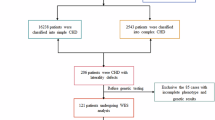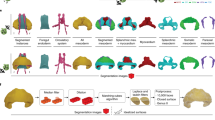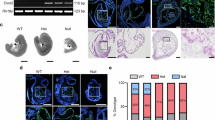Abstract
Malformations of the septum, outflow tract and aortic arch are the most common congenital cardiovascular defects and occur in mice lacking Cited2, a transcriptional coactivator of TFAP2. Here we show that Cited2−/− mice also develop laterality defects, including right isomerism, abnormal cardiac looping and hyposplenia, which are suppressed on a mixed genetic background. Cited2−/− mice lack expression of the Nodal target genes Pitx2c, Nodal and Ebaf in the left lateral plate mesoderm, where they are required for establishing laterality and cardiovascular development. CITED2 and TFAP2 were detected at the Pitx2c promoter in embryonic hearts, and they activate Pitx2c transcription in transient transfection assays. We propose that an abnormal Nodal-Pitx2c pathway represents a unifying mechanism for the cardiovascular malformations observed in Cited2−/− mice, and that such malformations may be the sole manifestation of a laterality defect.
This is a preview of subscription content, access via your institution
Access options
Subscribe to this journal
Receive 12 print issues and online access
$259.00 per year
only $21.58 per issue
Buy this article
- Purchase on SpringerLink
- Instant access to full article PDF
Prices may be subject to local taxes which are calculated during checkout







Similar content being viewed by others
References
Bruneau, B.G. Transcriptional regulation of vertebrate cardiac morphogenesis. Circ. Res. 90, 509–519 (2002).
Goodman, R.H. & Smolik, S. CBP/p300 in cell growth, transformation, and development. Genes Dev. 14, 1553–1577 (2000).
Petrij, F. et al. Rubinstein-Taybi syndrome caused by mutations in the transcriptional co-activator CBP. Nature 376, 348–351 (1995).
Stevens, C.A. & Bhakta, M.G. Cardiac abnormalities in the Rubinstein-Taybi syndrome. Am. J. Med. Genet. 59, 346–348 (1995).
Bhattacharya, S. et al. Functional role of p35srj, a novel p300/CBP binding protein, during transactivation by HIF-1. Genes Dev. 13, 64–75 (1999).
Dunwoodie, S.L., Rodriguez, T.A. & Beddington, R.S.P. Msg1 and Mrg1, founding members of a gene family, show distinct patterns of gene, expression during mouse embryogenesis. Mech. Dev. 72, 27–40 (1998).
Sun, H.B., Zhu, Y.X., Yin, T., Sledge, G. & Yang, Y.C. MRG1, the product of a melanocyte-specific gene related gene, is a cytokine-inducible transcription factor with transformation activity. Proc. Natl. Acad. Sci. USA 95, 13555–13560 (1998).
Freedman, S.J. et al. Structural basis for negative regulation of hypoxia-inducible factor-1α by CITED2. Nat. Struct. Biol. 10, 504–512 (2003).
Bamforth, S.D. et al. Cardiac malformations, adrenal agenesis, neural crest defects and exencephaly in mice lacking Cited2, a new Tfap2 co-activator. Nat. Genet. 29, 469–474 (2001).
Barbera, J.P. et al. Folic acid prevents exencephaly in Cited2 deficient mice. Hum. Mol. Genet. 11, 283–293 (2002).
Weninger, W.J. & Mohun, T. Phenotyping transgenic embryos: a rapid 3-D screening method based on episcopic fluorescence image capturing. Nat. Genet. 30, 59–65 (2002).
Yin, Z. et al. The essential role of Cited2, a negative regulator for HIF-1α, in heart development and neurulation. Proc. Natl. Acad. Sci. USA 99, 10488–10493 (2002).
Schneider, J.E. et al. Rapid identification and 3D reconstruction of complex cardiac malformations in transgenic mouse embryos using fast gradient echo sequence magnetic resonance imaging. J. Mol. Cell. Cardiol. 35, 217–222 (2003).
Kranc, K.R. et al. Transcriptional Coactivator Cited2 Induces Bmi1 and Mel18 and Controls Fibroblast Proliferation via Ink4a/ARF. Mol. Cell. Biol. 23, 7658–7666 (2003).
Braganca, J. et al. Physical and Functional Interactions among AP-2 Transcription Factors, p300/CREB-binding Protein, and CITED2. J. Biol. Chem. 278, 16021–16029 (2003).
Glenn, D.J. & Maurer, R.A. MRG1 Binds to the LIM Domain of Lhx2 and may function as a coactivator to stimulate glycoprotein hormone alpha-subunit gene expression. J. Biol. Chem. 274, 36159–36167 (1999).
Brewer, S., Jiang, X., Donaldson, S., Williams, T. & Sucov, H.M. Requirement for AP-2α in cardiac outflow tract morphogenesis. Mech. Dev. 110, 139–149 (2002).
Satoda, M. et al. Mutations in TFAP2B cause Char syndrome, a familial form of patent ductus arteriosus. Nat. Genet. 25, 42–46 (2000).
Thomas, T., Yamagishi, H., Overbeek, P.A., Olson, E.N. & Srivastava, D. The bHLH factors, dHAND and eHAND, specify pulmonary and systemic cardiac ventricles independent of left-right sidedness. Dev. Biol. 196, 228–236 (1998).
Gage, P.J., Suh, H. & Camper, S.A. Dosage requirement of Pitx2 for development of multiple organs. Development 126, 4643–4651 (1999).
Kitamura, K. et al. Mouse Pitx2 deficiency leads to anomalies of the ventral body wall, heart, extra- and periocular mesoderm and right pulmonary isomerism. Development 126, 5749–5758 (1999).
Lin, C.R. et al. Pitx2 regulates lung asymmetry cardiac positioning and pituitary and tooth morphogenesis. Nature 401, 279–282 (1999).
Lu, M.F., Pressman, C., Dyer, R., Johnson, R.L. & Martin, J.F. Function of Rieger syndrome gene in left-right asymmetry and craniofacial development. Nature 401, 276–278 (1999).
Liu, C., Liu, W., Lu, M.F., Brown, N.A. & Martin, J.F. Regulation of left-right asymmetry by thresholds of Pitx2c activity. Development 128, 2039–2048 (2001).
Liu, C. et al. Pitx2c patterns anterior myocardium and aortic arch vessels and is required for local cell movement into atrioventricular cushions. Development 129, 5081–5091 (2002).
Hamada, H., Meno, C., Watanabe, D. & Saijoh, Y. Establishment of vertebrate left-right asymmetry. Nat. Rev. Genet. 3, 103–113 (2002).
Saijoh, Y., Oki, S., Ohishi, S. & Hamada, H. Left-right patterning of the mouse lateral plate requires nodal produced in the node. Dev. Biol. 256, 160–172 (2003).
Meno, C. et al. Diffusion of nodal signaling activity in the absence of the feedback inhibitor Lefty2. Dev. Cell 1, 127–138 (2001).
Saijoh, Y. et al. Left-right asymmetric expression of lefty2 and nodal is induced by a signaling pathway that includes the transcription factor FAST2. Mol. Cell 5, 35–47 (2000).
Shen, M.M., Wang, H. & Leder, P. A differential display strategy identifies Cryptic, a novel EGF-related gene expressed in the axial and lateral mesoderm during mouse gastrulation. Development 124, 429–442 (1997).
Yamamoto, M. et al. Nodal signaling induces the midline barrier by activating Nodal expression in the lateral plate. Development 130, 1795–1804 (2003).
Shiratori, H. et al. Two-step regulation of left-right asymmetric expression of Pitx2: initiation by nodal signaling and maintenance by Nkx2. Mol. Cell 7, 137–149 (2001).
Prestridge, D.S. SIGNAL SCAN: a computer program that scans DNA sequences for eukaryotic transcriptional elements. Comput. Appl. Biosci. 7, 203–206 (1991).
Brennan, J., Norris, D.P. & Robertson, E.J. Nodal activity in the node governs left-right asymmetry. Genes Dev. 16, 2339–2344 (2002).
Norris, D.P., Brennan, J., Bikoff, E.K. & Robertson, E.J. The Foxh1-dependent autoregulatory enhancer controls the level of Nodal signals in the mouse embryo. Development 129, 3455–3468 (2002).
Yan, Y.T. et al. Conserved requirement for EGF-CFC genes in vertebrate left-right axis formation. Genes Dev. 13, 2527–2537 (1999).
Gaio, U. et al. A role of the cryptic gene in the correct establishment of the left-right axis. Curr. Biol. 9, 1339–1342 (1999).
Pena, P. et al. Activator protein-2 mediates transcriptional activation of the CYP11A1 gene by interaction with Sp1 rather than binding to DNA. Mol. Endocrinol. 13, 1402–1416 (1999).
Waterston, R.H. et al. Initial sequencing and comparative analysis of the mouse genome. Nature 420, 520–562 (2002).
Kent, G.C. & Carr, R.K. Comparative Anatomy of the Vertebrates 314–350 (McGraw Hill, Boston, 2001).
Clark, E.B. Etiology of congenital cardiac malformations: epidemiology and genetics. in Moss and Adams' Heart Disease in Infants, Children, and Adolescents (eds. Allen, H.D., Gutgessell, H.P., Clark, E.B. & Driscoll, D.J.) 64–79 (Lipincott Williams & Wilkins, Philadelphia, 2001).
Wilkinson, D.G. Whole mount in situ hybridization of vertebrate embryos. in In situ Hybridization (ed. Wilkinson, D.G.) 75–83 (IRL, Oxford, 1992).
Ryan, A.K. et al. Pitx2 determines left-right asymmetry of internal organs in vertebrates. Nature 394, 545–551 (1998).
Tatusova, T.A. & Madden, T.L. BLAST 2 Sequences, a new tool for comparing protein and nucleotide sequences. FEMS Microbiol. Lett. 174, 247–250 (1999).
Ausubel, F. et al. Short Protocols in Molecular Biology (John Wiley & Sons, 1995).
Boyd, K.E., Wells, J., Gutman, J., Bartley, S.M. & Farnham, P.J. c-Myc target gene specificity is determined by a post-DNA binding mechanism. Proc. Natl. Acad. Sci. USA 95, 13887–13892 (1998).
Brown, N.A. & Anderson, R.H. Symmetry and laterality in the human heart: developmental implications. in Heart Development (eds. Harvey, R.P. & Rosenthal, A.) 447–462 (Academic, San Diego, 1999).
Kaufman, M. & Bard, J.B.L. The Anatomical Basis of Mouse Development 33–46 (Academic, San Diego, 1999).
Acknowledgements
We thank H. Hamada, H. Shiratori, H. Hurst and P. Riley for reagents; H. Koseki and Y. Fujimura for ChIP protocols; and R. Copley for discussions. C.R.F. is a Wellcome Trust Prize Student, and S.B. a Wellcome Trust Senior Research Fellow. These studies were funded by the Wellcome Trust.
Author information
Authors and Affiliations
Corresponding author
Ethics declarations
Competing interests
The authors declare no competing financial interests.
Supplementary information
Supplementary Fig. 1
Pitx2c, Tcfap2, Cited2 and Actb (β-actin, control) expression was assessed using RT-PCR. (PDF 294 kb)
Rights and permissions
About this article
Cite this article
Bamforth, S., Bragança, J., Farthing, C. et al. Cited2 controls left-right patterning and heart development through a Nodal-Pitx2c pathway. Nat Genet 36, 1189–1196 (2004). https://doi.org/10.1038/ng1446
Received:
Accepted:
Published:
Issue date:
DOI: https://doi.org/10.1038/ng1446
This article is cited by
-
Msx1 haploinsufficiency modifies the Pax9-deficient cardiovascular phenotype
BMC Developmental Biology (2021)
-
Novel Point Mutations of CITED2 Gene Are Associated with Non-familial Congenital Heart Disease (CHD) in Sporadic Pediatric Patients
Applied Biochemistry and Biotechnology (2020)
-
Cited2 regulates proliferation and survival in young and old mouse cardiac stem cells
BMC Molecular and Cell Biology (2019)
-
Exogenous WNT5A and WNT11 proteins rescue CITED2 dysfunction in mouse embryonic stem cells and zebrafish morphants
Cell Death & Disease (2019)
-
Reply to ‘Double-outlet right ventricle is not hypoplastic left heart syndrome’
Nature Genetics (2019)



